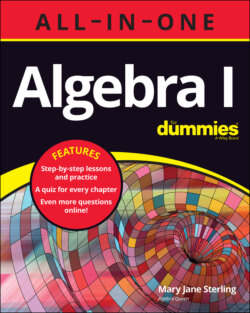Читать книгу Algebra I All-in-One For Dummies - Mary Jane Sterling, Mary Sterling Jane - Страница 86
Multiplying and dividing fractions
ОглавлениеMultiplying fractions is really a much easier process than adding or subtracting fractions, because you don’t have to find a common denominator. Furthermore, you can take some creative steps and reduce the fractions before you even multiply them.
When multiplying fractions, you can pair up the numerator of any fraction in the problem with the denominator of any other fraction; then divide each by the same number (reduce). Doing so saves you from having large numbers to multiply and then to reduce later.
Yes, multiplying fractions is a tad easier than adding or subtracting them. Multiplying is easier because you don’t need to find a common denominator first. The only catch is that you have to change any mixed numbers to improper fractions. Then, at the end, you may have to change the fraction back again to a mixed number. Small price to pay.
When multiplying fractions, follow these steps:
1 Change all mixed numbers to improper fractions.
2 Reduce any numerator-denominator combinations, if possible.
3 Multiply the numerators together and the denominators together.
4 Reduce the answer if necessary.
Here’s an example: Suppose Sadie worked hours at time-and-a-half. How many hours will she get paid for?
Write the problem as and then rewrite the mixed numbers as improper fractions. . Reducing the fractions before multiplying can make multiplying the fractions easier. Smaller numbers are more manageable, and if you reduce the fractions before you multiply, you don’t have to reduce them afterward.
The product has a 32 in the first numerator and a 2 in the second denominator. Even though the 32 and 2 aren’t in the same fraction, you can reduce them because this is a multiplication problem. Multiplication is commutative, meaning that it doesn’t matter what order you multiply the numbers. You can pretend that the 32 and 2 are in the same fraction. So, dividing the first numerator by 2 and the second denominator by 2, you get
But has a 3 in the first denominator and a 3 in the second numerator, so you can divide by 3: .
Dividing fractions is as easy as (dividing) pie — that is, dividing the pie into enough pieces so that everybody at your table gets an equal share. Actually, dividing fractions uses the same techniques as multiplying fractions, except that there’s an additional “first step”: the numerator and the denominator of the second fraction first have to change places — the fraction does a “flip.”
When dividing fractions:
1 Change all mixed numbers to improper fractions.
2 Flip the second fraction, placing the bottom number on top and the top number on the bottom.
3 Change the division sign to multiplication.
4 Continue as with the multiplication of fractions.
The flip of a fraction is called its reciprocal. All real numbers except 0 have a reciprocal. The product of a number and its reciprocal is equal to 1.
Consider this example: If you buy pounds of sirloin steak and want to cut it into pieces that weigh pound each, how many pieces will you have?
First, change the mixed number to an improper fraction. Then flip the second fraction, and change the division to multiplication:
Now reduce the fraction and multiply. Change the answer to a mixed number:
Having pieces means that you’ll have eight pieces weighing the full pound and one piece left over that’s smaller. (That’s the cook’s bonus or mean Aunt Martha’s piece.)
Q. Multiply the three fractions: .
A. You can make the problem easier if you reduce the fractions first. The 15 and 75 are both divisible by 15, the 21 and 49 are both divisible by 7, and the 16 and 24 are both divisible by 8:
Q. Divide:
A. First change the 2 to a fraction: . Then change the divide to multiply and the second (right) fraction to its reciprocal. Then do the multiplication problem to get the answer , which can be changed to the mixed number.
32
33
34
35
36
37
